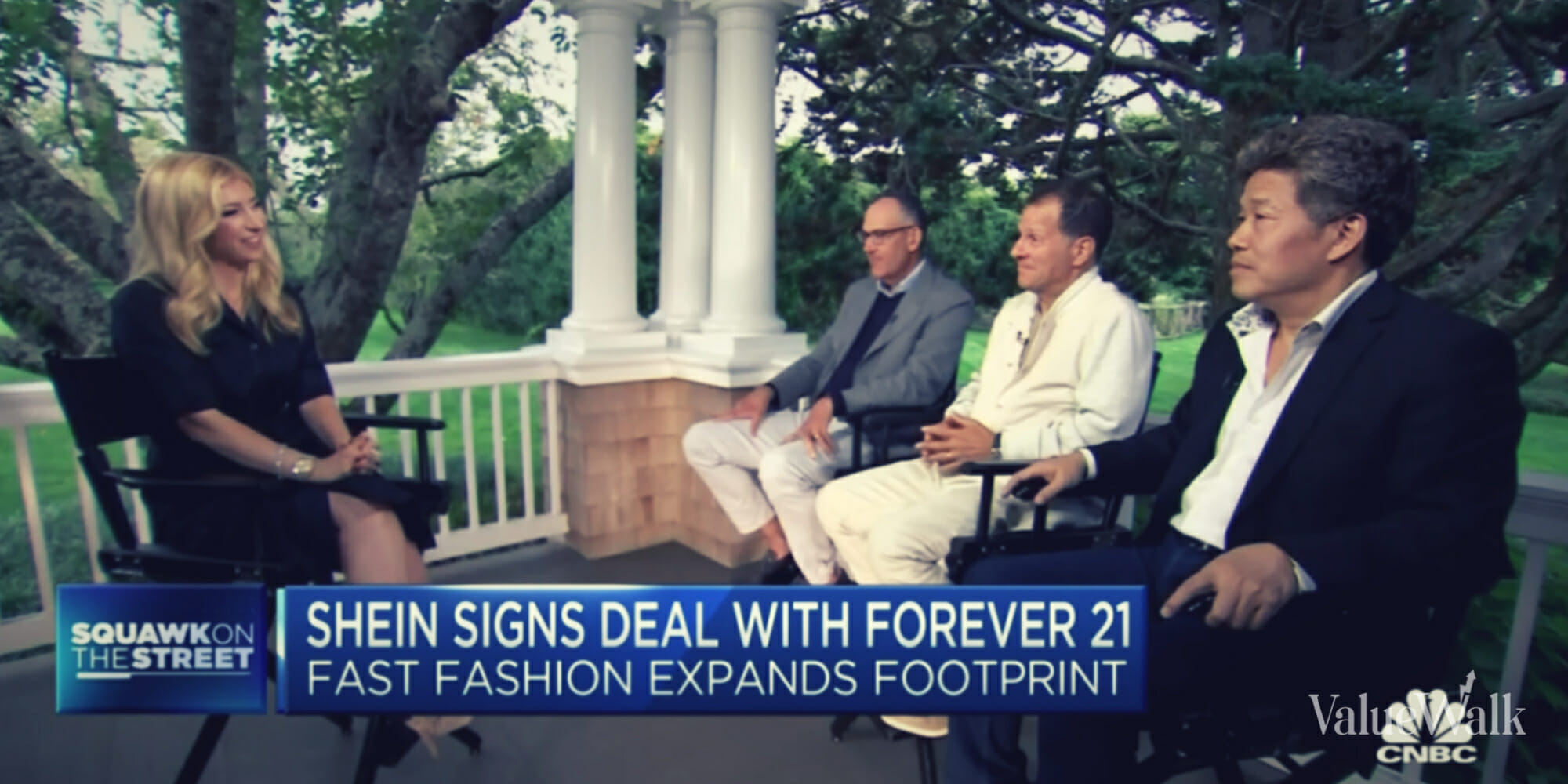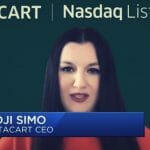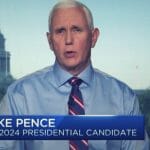Following is the unofficial transcript of a CNBC exclusive interview with Authentic Brands CEO Jamie Salter, Simon Property Group CEO David Simon and SHEIN Executive Chairman Donald Tang that aired during CNBC’s “Squawk on the Street” (M-F, 9AM-12PM ET) today, Friday, August 25.
Shein Signs Deal With Forever 21 As Fast Fashion Expands Footprint
PART I
JAMIE SALTER: I mean I was really looking, you know, I’m always looking at who’s successful in the marketplace. And I was noticing that there was this company called SHEIN, S-H-E-I-N, and I was looking at data and seeing that they were just performing better and better and they were taking more market share from really the fast fashion, you know, retailers.
Well, what’s interesting is they have 150 million customers. SPARC actually has 200 million customers, different customers. Customers that actually come into the stores and physically shop. And, of course, you know, some of those customers are also online because SPARC, you know, has seven brands in its portfolio today, you know, whether it’s Forever 21 or Brooks Brothers or Reebok, Lucky, Eddie Bauer, Aéropostale. So I think what’s so interesting, you know, about sort of their customers and our customers, there will be overlap. There, they’ll be their customers that want to buy other brands. And not just the SHEIN brand, you know, they’ll want to buy Forever 21. So—
SARA EISEN: But does SHEIN clothing get sold in now Forever 21?
SALTER: So, we will be testing definitely some shop-in-shops in the Forever 21 stores. And, you know, obviously we have nice landlords that will allow us to do that. And we will test those shop-in-shops. And our belief based on the pop-ups that SHEIN has done in the past that that will be incredibly exciting for the Forever 21 customer. And, you know, it will obviously drive an enormous amount of traffic, you know, into the malls, which is good from a Simon point of view, but it’s also very good from a Forever 21 point of view. Return to store. That’s something that, you know, we’ve studied sort of a little bit of what Kohl’s has been doing with Amazon with return to store. So that is something that we’ve also discussed.
EISEN: SHEIN returns can come back to—
SALTER: Yes, so SHEIN returns,
EISEN: The stores at the Simon malls.
SALTER: Coming back to the Forever 21 stores, getting that credit. And then, you know, obviously hopefully they will spend that credit in the SHEIN shop-in-shop or in the Forever 21 store.
DAVID SIMON: Yeah, but it’s, I think it’s our goal to, you know, to use both of our distribution networks back and forth. So SHEIN comes onto our platform, which is essentially mostly physical environment, right, so shop-in-shop in the Forever 21 store. I’ve happened to see a couple pop-ups that SHEIN’s done and one in Riyadh just recently in June, and it was incredible. There was a line out. Then they did a pop-up in Indianapolis. I think that was just to seal the deal, so they wanted to show me what the line was outside my hometown.
But and the line for the consumers to come into the, you know, and this was maybe a week, you know, their, your stores are, like, for a week or two or whatever but the line to get into that was great, so I think introducing SHEIN in a broader, more physical way will be beneficial for SHEIN. At the same time, we can put Forever 21 on their marketplace and expose all of the great stuff and all the, all the product that F-21 has on the SHEIN marketplace will, and expose it to the 150 million consumers. So that will be what we want to learn from each other. And but we expect it to accelerate the growth of both companies, because we can use both of our distribution networks.
EISEN: Yeah, for the first time, you get physical retail exposure, right? Forever 21 has—
DONALD TANG: Absolutely.
EISEN: More than 400 stores in the U.S. How much is that is part of the vision and the growth plan for SHEIN?
TANG: Well, we’re always looking at customers, the consumer first. You know, whatever consumer want, we’ll try to give it to them. And we want to go deeper and wider and broader.
PART II
EISEN: You told me this was the most transformational deal to hit fashion in the, in the last ten years. Why do you think that is?
SALTER: Because, you know, how fast they deliver and the way their supply chain works between the vendors, okay, and the suppliers, and when I say vendors and suppliers, the fabric makers and the and then the designers, and then, and then the sew-, it’s for us, we design something here in New York City, then we send it over, okay, to one of our factories. Our factory makes us a sample, they send it back, we approve it. And you know, six months later we deliver it. They do it all in seven days.
EISEN: Yeah, they changed the game.
SALTER: Okay? They’ve changed the game. And if we can actually do that across our portfolio, I mean we’re going to know what you want when you want it. And you know, I don’t want to bring up waste, but they run with 2% inventory, okay, we run with a lot more than that at SPARC. So I truly believe it’s going to change the game from a markdown standpoint, okay, from an inventory standpoint, from a cash flow standpoint, working capital. There’s just so many things that are going to change because of this relationship. So yes, I do believe it’s changing the game of retail. And I think that other retailers are going to have to learn what SHEIN’s doing if they want to compete because they’re just faster and better at understanding the customer.
TANG: Well, we’re always looking at customers, the consumer first. You know, whatever consumer want, we’ll try to give it to them. And we want to go deeper and wider and broader. And, by the way, you know, when David was mentioning Indiana, we also have a big warehouse, a big hub there in Whitestown. Indiana has quite a few, quite a few hundred, perhaps going to be thousands of workers there.
SALTER: I think, I think that what’s really important is, look, I’m a brand guy. And I can honestly say that when I study brands, if you could say, you know, how many brands do you know are strictly an e-commerce brand and only an e-commerce brand, they’re not a physical brand, my guess is maybe you can name one, maybe you can name two, but you probably can’t name too many—
EISEN: You have to be both.
SALTER: That you’d be successful. At the same time, I don’t think you could name a single brand that is only in physical retail and not digital. So, I think that this partnership is incredibly important because it does give physical to SHEIN to test and actually build physical retail and give that experience to the consumer. At the same time, it gives us the ability to do a lot more digital retail because let’s—
EISEN: You dominate.
SALTER: Let’s be honest, they have the fastest, best digital platform on the planet right now. And nobody is remotely close to how good they are when it comes to digital retail.
EISEN: But Jamie, isn’t it a risk doing this deal and business with a Chinese company right now?
SALTER: I, look, I’m glad you asked that question because it’s not a Chinese company for starters. I, you know, and not that I don’t have a problem with China. We do business in China with some of our brands. This is a Singapore company, that’s who we did the deal with. Yes, they manufacture in China. By the way, we manufacture in China too. So does the Gap, so does, so does, you know, Walmart, so do many other retailers, okay, manufacture goods in China. Yes, we manufacture in lots of other places around the world. But at the end of the day, SHEIN does not do any business actually in China other than manufacturing goods.
EISEN: Is SHEIN a Chinese company, Donald?
TANG: SHEIN was born in China, 2021 that we moved to Singapore, and also currently headquartered in Singapore. We do business globally with more than 150 countries and we do no business in China currently.
EISEN: No consumer business.
TANG: No consumer business, but we do have significant amount of supply chain in China. Although we are—
SALTER: But that’s no different than we have supply chain in China and so do, so do many other companies.
EISEN: But I do wonder, I mean, I know. Look, it’s gotten caught in the crosshairs of U.S. politics and tensions have only gone from bad to worse with China and companies like TikTok are constantly in the news, and politicians want to ban it. Do you worry that if things do get worse, it’s gonna end up hurting your business in the U.S. and you’ll be caught in the middle?
TANG: Well, there are a lot of those speculations out there, but we believe that U.S. is an open market and some of those issues will be addressed by the people who are much above my pay grade to really address that. But what we do is to be responsible, corporate citizen. We want to be a global corporate citizen doing business responsibly.
EISEN: What about some of the other criticisms that are out—
TANG: Right. On cotton.
EISEN: There including the ethical concerns around your supply chain? The Uyghur cotton—
TANG: Right, so let’s—
EISEN: The work conditions.
TANG: The cotton’s the biggest issue there. So what on that particular issue, number one, we do not source cotton from China, right? We use the imported cotton to make products in China, our cotton-based products. And our cotton-based products is about 4% of our entire business. And the way that we are taking steps to make sure that we comply with the law is, number one, that we have a code of conduct in every single factory who’s a subcontractor of ours they will have to sign. That’s one.
The second step is we have the international independent, renowned auditors to come in to do unannounced audits, to make sure that everything that they say, they actually do, right? So they have no supply chain factories or sourcing materials from unapproved region, right? So the third step that we’re taking is we have, we have the proprietary technology which is tracing where the material’s coming from, from operational line, from invoicing the financial, the invoicing line and also the logistics line.
Those three lines that we trace all of the materials, raw materials where they’re coming from. If they see something from unapproved regions, we take them down right away. Then number four is the testing that we use — which is the leading testing agency or company which Congress and the CDP uses as well to test all of the materials coming into the United States on a random basis, every single – that we have, right? So these are the—
EISEN: I imagine you’re doing a lot of explaining of this to the U.S. lawmakers.
TANG: Well, that, yes. And then I think the better way and, you know, Mr. Simon and Mr. Salter all said, you know, you got to do it better, right? So we’re now we’re just approved today the cotton video that we’re going to send to our stakeholders.
SALTER: What I, what I would add is we have rigorous compliance rules.
EISEN: I’m curious, David, how it fits into your strategy as the head of Simon Property. Because increasingly, we’ve seen you invest in JCPenney and SPARC, and now this deal, going more into retail. How does that fit in with your strategy?
SIMON: Well, we’re very, retail is very small for us. So my goal is ultimately, hopefully that SHEIN loves, you know, shop-in-shops, loves being, having the ability to talk to their consumer in the physical world. And then ultimately one day they have 1,000 stores—
EISEN: Open stores in your malls.
SIMON: Okay so, you know, that’s our goal, okay—
SALTER: You’ll need to talk to me about this.
SIMON: Okay, that’s our goal. I’m going to negotiate the rent, you’re going to stay out of it—
SALTER: Stay close to me.
SIMON: But that’s the goal. Our, you know, it’s funny, because the market, you know, I call it our extra-curricular activity; 95% of our income is on our traditional real estate, bricks and mortar, whether it’s office, retail, residential, all the stuff that we do international. But we’ve been very profitable in this other side of our business. But we don’t, you know, we’re perfectly happy where it is. We’ve created an enormous value for our shareholders. But it’s not like we’re on a mission to grow it. We’re on a mission to create more and more profitability and be opportunistic in some of these investments that we have.












